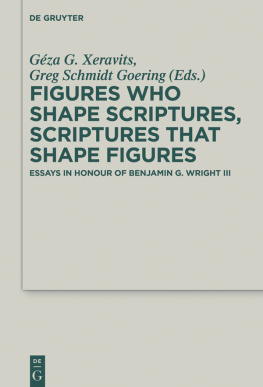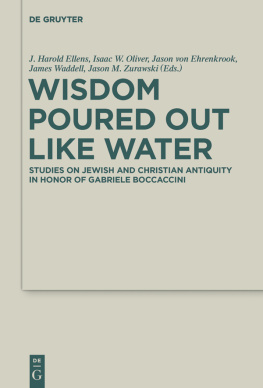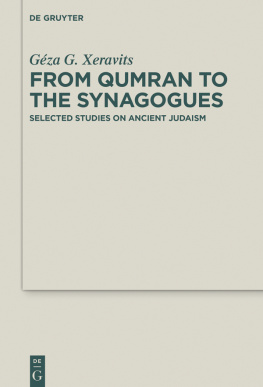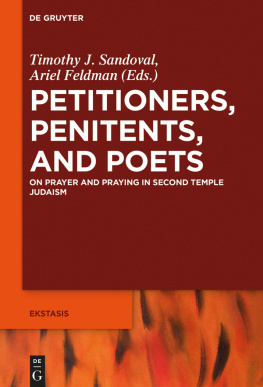Contents
Guide

Figures who Shape Scriptures, Scriptures that Shape Figures
Deuterocanonical and Cognate Literature Studies

Edited by
Friedrich V. Reiterer, Beate Ego, Tobias Nicklas and Kristin de Troyer
Volume 40

ISBN 978-3-11-058646-6
e-ISBN (PDF) 978-3-11-059637-3
e-ISBN (EPUB) 978-3-11-059309-9
ISSN 1865-1666
Library of Congress Cataloging-in-Publication Data
A CIP catalog record for this book has been applied for at the Library of Congress.
Bibliographic information published by the Deutsche Nationalbibliothek
The Deutsche Nationalbibliothek lists this publication in the Deutsche Nationalbibliografie; detailed bibliographic data are available on the Internet at http://dnb.dnb.de.
2018 Walter de Gruyter GmbH, Berlin/Boston
www.degruyter.com
Preface
Benjamin G. Wright, III, University Distinguished Professor in the Department of Religion Studies, Lehigh University, launched the public portion of his academic career in 1979, with a research report to the Philadelphia Seminar on Christian Origins on The Figure of Phineas in Philo. In 2019, then, one year from the publication of the present volume, Ben will have completed four decades of a still unfinished yet already remarkable scholarly career. So it is fitting, as Ben reaches this forty-year milestone in his careeras well as his sixty-fifth birthday in January 2018to pause and reflect on the impact of Bens life and work as a scholar, teacher, mentor, and mensch .
Bens scholarly writing treats a wide range of subjects in the history and religion of early Judaism and Christianity through the end of the first century CE. His repertoire revolves primarily around two gravitational centers: Hellenistic Jewish literature from the Second Temple Periodespecially Jewish wisdom literatureand issues of translating Jewish literature from Hebrew into Greek. These two interests took shape during his doctoral work in Christian Origins at the University of Pennsylvania, under the direction of Robert Kraft. His dissertationcompleted in 1988 and published as No Small Difference with Scholars Press the following yearon translation technique in the book of Sirach took up the thorny problem of the relationship between the grandsons Greek translation and its supposed Hebrew vorlage . The project was pioneering for at least two reasons. First, Bens dissertation was one of the earliest to analyze ancient texts by means of computers. Using digital texts from the newly established Computer Assisted Tools for Septuagint Studies (CATSS) project, he compared the Greek versions of Sirach to the Hebrew versions and to other Greek translations of the Bible on a scale nearly impossible to achieve without these new computational tools. Second, he demonstrated that Ben Siras grandson used a relatively free translation technique. This suggests that modern scholars, contrary to prevailing assumptions, cannot responsibly use the Greek texts of Sirach to reconstruct an original Hebrew parent text, especially when the Hebrew is missing or uncertain. Nearly thirty years after the dissertations publication, Sirach scholars are still absorbing and wrestling with the implications of Bens doctoral research.
Bens publishing since his first monograph has proceeded at a dizzying pace. As of this writing, he has seven books in print, with two additional book-length commentaries on Sirach underway. In addition to No Small Difference , he has published a commentary on the Letter of Aristeas; a book on The Apocryphal Ezekiel, with Michael Stone and David Satran; a collection of his own essays on Sirach, Aristeas, and the Septuagint; two edited volumes of essays; and a translation of the Septuagint, coedited with Albert Pietersma. In addition, Ben has written more than seventy scholarly articles in peer-reviewed journals and edited volumes, numerous scholarly notes, more than thirty encyclopedia articles, numerous introductions or commentaries on ancient works in handbooks of various kinds, and more than sixty book reviews. Perusing Bens curriculum vitae, I am struck by the number of multi-author projects on which Ben has collaborated, a testament to his unusual collegiality.
Ben has become especially renowned as a scholar of Sirach. In addition to his first book, he has published dozens of scholarly articles on the text. The choice of Ben to write both the Hermeneia and the Society of Biblical Literature (SBL) commentaries on Sirach testifies to his status as the foremost expert on the subject, not only in North America but also in the entire world. The breadth of his impact, however, extends well beyond Sirach scholarship. Bens voluminous scholarly corpus has deepened and broadened our understanding of a wide range of issues regarding the Septuagint, Jewish wisdom literature, and translation technique. His recently published and erudite commentary for de Gruyter on the Letter of Aristeasthe first ever complete and comprehensive commentary on the workdemonstrates a depth of understanding both of the Letter itself as well as of the broad Greek literary context in which it belongs. His extensive scholarly work on the Septuagint and on translation issues crystalized practically in the New English Translation of the Septuagint (NETS), which Ben co-edited, and for which Ben provided the translations for Sirach and The Epistle of Ieramias. The achievement represents the first complete translation of the Septuagint into a modern language since the 19 th century. A second edition of the NETS is underway. Bens work on the Septuagint has promoted a sea change in scholarship: from viewing the Septuagint primarily for its value to text critics as a witness to the earliest Hebrew Bible manuscripts, to seeing it as a corpus that helps us understand Hellenistic Judaism. In sum, Ben has contributed profoundly to our understanding of early Jewish wisdom and other Hellenistic literature, scribal culture, translation and transmission practices, pseudepigraphic habits, Jewish identity, the role of sacred texts, among other topics.
Beyond his own scholarly writings, Ben has played an outsized role in fostering the scholarship of others. His impact on the field includes his extraordinary roles as Editor and Associate Editor for the Journal for the Study of Judaism Supplements monograph series, Co-Editor in Chief for the SBL Commentary on the Septuagint, Area Editor for The Encyclopedia of the Bible and Its Reception , member of the editorial board for the Deuterocanonical and Cognate Literature Series at de Gruyter, Secretary, Vice-President, and President of the Executive Committee of the International Organization for Septuagint and Cognate Studies, member of the editorial boards of numerous journals, and for his service on various program units of the SBL. In addition, he has mentored numerous graduate students, serving as an external reader or examiner on at least five dissertation committees, quite an achievement for someone who teaches in an undergraduate program. Without exhausting his role in fostering the scholarship of others, I will mention one final contribution: informally mentoring young scholars in the field. Many of my colleagues and I have personally benefitted from Bens guidance in many ways, large and small, from phone consultations, to commenting on draft articles, from constructive criticism of presentations, to engaging us in conversations over meals and drinks. All of the ways in which Ben has fostered the scholarly pursuits of others points to his selflessness and generous spirit.












